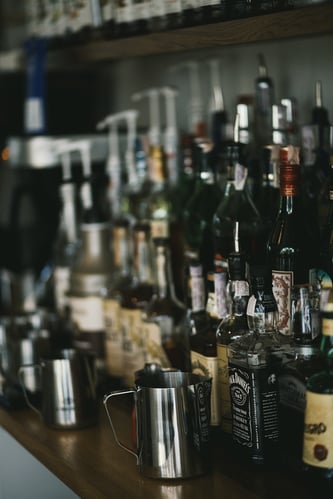 Chapter 3: Location, Location, Location
Chapter 3: Location, Location, Location
When it comes to opening a bar, choosing the right location can make all the difference. This chapter explores the importance of finding the perfect spot for your bar and how it can contribute to your success in the competitive hospitality industry.
The first factor to consider when selecting a location for your bar is foot traffic. Look for areas with high pedestrian activity, such as bustling downtown areas, popular shopping districts, or vibrant neighborhoods. A steady flow of potential customers passing by your bar increases the chances of attracting new patrons and generating consistent business.
Competition is another crucial aspect to evaluate. While some level of competition can indicate a thriving market, it's important to find a location where you can stand out and offer something unique. Research existing bars in the area and assess their target audience, concept, and atmosphere. Identify gaps in the market that you can fill or consider differentiating yourself through a specialized theme, signature cocktails, or exceptional service.
The overall vibe of the neighborhood plays a significant role in the success of your bar. Consider the demographic of the area and whether it aligns with your target audience. For instance, a trendy, up-and-coming neighborhood might attract a younger crowd interested in craft cocktails and live music, while a more established residential area might cater to a more relaxed, family-oriented clientele. Understanding the local culture and preferences will help you create a bar that resonates with the community.
Now, let's talk about bar inventory and bar inventory software. Once you've secured a location, effective inventory management becomes crucial to your bar's profitability. Bar inventory software can simplify this process by providing real-time tracking of stock levels, helping you optimize purchasing decisions and reduce waste.
With bar inventory software, you can easily monitor the usage of ingredients, track sales trends, and generate detailed reports. This data-driven approach allows you to make informed decisions about menu offerings, pricing, and reordering. By efficiently managing your inventory, you can minimize costs and maximize profits.
In conclusion, choosing the right location is key to the success of your bar. Consider factors such as foot traffic, competition, and the neighborhood's vibe when making your decision. Additionally, implementing bar inventory software ensures efficient inventory management, leading to better cost control and profitability. By optimizing both your physical location and inventory processes, you'll set a solid foundation for a thriving bar business.
Liquor Inventory Experts
Topics: Bar inventory, bar inventory levels, bar profitability, managing liquor inventory cost, opening a bar, bar location, bar inventory system, bar inventory software, bar inventory app
Chapter 2: Navigating Licenses and Permits When it comes to opening a bar, one of the most important aspects to consider is obtaining the necessary licenses and permits. This chapter will guide you through the complex world of legal requirements, ensuring that you have all the paperwork in order to operate your establishment smoothly and legally.
When it comes to opening a bar, one of the most important aspects to consider is obtaining the necessary licenses and permits. This chapter will guide you through the complex world of legal requirements, ensuring that you have all the paperwork in order to operate your establishment smoothly and legally.
Obtaining licenses and permits can vary depending on your location, so it's crucial to research the specific regulations in your area. From liquor licenses to health permits, you'll need to understand the specific requirements and processes involved.
One critical aspect of running a bar is managing your inventory effectively. Keeping track of the stock levels, tracking usage, and ensuring timely restocking are vital for smooth operations. This is where bar inventory management software can be a game-changer.
Bar inventory software is designed to streamline the inventory management process, making it more efficient and accurate. With advanced features like barcode scanning, real-time updates, and comprehensive reporting, it enables you to monitor your stock levels with ease. This software also helps in identifying trends, minimizing waste, and optimizing purchasing decisions.
Implementing bar inventory software can save you time, reduce errors, and ultimately improve profitability. It provides a centralized system for inventory control, eliminating the need for manual spreadsheets or guesswork. By automating tasks such as order generation and tracking, it allows you to focus more on providing exceptional customer experiences.
When selecting bar inventory software, consider factors such as user-friendliness, compatibility with your POS system, and scalability as your business grows. It's worth exploring different options and reading customer reviews to find a solution that aligns with your specific needs.
In conclusion, obtaining the necessary licenses and permits is a crucial step in opening a bar. Additionally, implementing bar inventory software can revolutionize the way you manage your inventory, providing efficiency, accuracy, and improved profitability. By staying informed on legal requirements and embracing technology, you'll navigate through this chapter successfully, setting a strong foundation for your bar's operations.
Topics: Bar inventory, bar inventory levels, bar inventory system, liquor control, bar inventory software
 When it comes to conducting bar inventory, there are several effective methods that establishments can employ to ensure accurate tracking and control of their inventory, particularly in terms of "bar inventory" and "liquor inventory." Let's explore some of these methods in detail:
When it comes to conducting bar inventory, there are several effective methods that establishments can employ to ensure accurate tracking and control of their inventory, particularly in terms of "bar inventory" and "liquor inventory." Let's explore some of these methods in detail:
-
Manual Counting: This traditional method involves physically counting each item in the bar inventory. Bar staff or managers manually record the quantities of liquor bottles, beer kegs, wine bottles, mixers, and other bar supplies. While time-consuming, manual counting provides a hands-on approach to verify inventory levels accurately.
-
Barcode Scanning: Utilizing barcode scanning technology streamlines the inventory process. Each item is assigned a unique barcode, and a barcode scanner is used to scan items during the inventory count. This method enables quick and accurate recording of quantities, reducing human errors and saving time.
-
Digital Inventory Management Systems: Bar owners can leverage digital inventory management software specifically designed for bar operations. These systems provide user-friendly interfaces to record and track inventory, generate reports, and analyze consumption patterns. Digital systems can also integrate with point-of-sale (POS) systems to automate inventory updates based on sales transactions.
-
Weighing Systems: For liquid inventory like liquor, weighing systems offer an efficient method. Liquor bottles are placed on scales that are calibrated to measure the weight accurately. By subtracting the tare weight of the bottle, the system calculates the liquor content remaining. This method is particularly useful for tracking high-value liquor inventory.
-
Periodic Spot Checks: In addition to regular inventory counts, periodic spot checks can help identify any discrepancies or potential issues. Bar managers randomly select specific items from the inventory and verify their quantities. This method provides an extra layer of control and helps ensure the accuracy of the overall inventory count.
-
Integration with POS Systems: Integrating bar inventory management with POS systems offers real-time tracking of sales and inventory. As sales are made, the POS system deducts the corresponding items from the inventory automatically. This integration minimizes manual effort and provides accurate, up-to-date inventory information.
In conclusion, employing effective methods for conducting bar inventory is essential for accurate tracking and control, particularly regarding "bar inventory" and "liquor inventory." Whether through manual counting, barcode scanning, digital inventory management systems, weighing systems, periodic spot checks, or integration with POS systems, bars can optimize their inventory management processes and ensure the accuracy of their stock levels, leading to improved profitability and customer satisfaction.
Topics: liquor inventory, Bar inventory, bar inventory levels, Hotel Inventory
The dictionary meaning of a dispenser is as follows: “a device that automatically dispenses a  single item or a measured quantity” In the hospitality industry, we are sometimes faced with a decision; do we want our liquor to be poured by way of a dispensing unit? Do we want our bartenders to be “automatic” and potentially take away any flair our personable bar staff has to offer our patrons?
single item or a measured quantity” In the hospitality industry, we are sometimes faced with a decision; do we want our liquor to be poured by way of a dispensing unit? Do we want our bartenders to be “automatic” and potentially take away any flair our personable bar staff has to offer our patrons?
Liquor dispensers are designed to specifically pour a pre configured amount in a glass, no more, no less. There can be certain advantages:
- Consistency of drinks
- Controls over quantity poured
- Less bartender training required
Liquor dispensers typically are available in two forms: guns & spigots.
Guns normally entail tubing to be run from the bar to an area where the liquor is poured into small vats. From there, as a product is selected at the bar, the liquor from the liquor room runs along the line into the patrons drinks. Many times, operators will limit the guns to rail product like vodka, gin, rum…or what we call high moving products.
Spigots or what can be best described as “time release valves” are systems in which a ring is placed around a nozzle on the bottle. When a portion of liquor is requested, the bottle is put through the activator ring, the lever is pressed and an electrical courant opens the valve to dispense a portion of liquid.
Although we may perceive these systems as the ultimate controls, there are a few things to consider:
- If you have several pouring stations, they can become cost prohibitive
- They can be impersonal: clients still like to see a bartender pour a drink straight into a glass without all the “mechanics” involved
- Sweet liquors have a tendency to crystallize and cause back ups in the lines and spigots thus requiring regular maintenance.
- Lack of inventory: as much as these systems can dispense exact amounts, they still require a separate system to conduct regular liquor inventories
In the end, as an operator, the decision lies in both the financial areas but also the image and feel you want your establishment to portray, both certainly will have an impact on your business and this is certainly a decision that takes time and research before adapting.
Topics: liquor inventory, Bar inventory, bar inventory levels, Bar staff, wine inventory, Bar Management, Wine Control, Liquor Inventory savings, inventory counting
Inventory count
 An inventory count can be best described as a physical inventory of what is currently in stock in the storage areas, comparing that count to what the liquor, beer and wine inventory count software thinks is in stock, and making any necessary adjustments to get the liquor, beer and wine inventory count software to match the storage area counts.
An inventory count can be best described as a physical inventory of what is currently in stock in the storage areas, comparing that count to what the liquor, beer and wine inventory count software thinks is in stock, and making any necessary adjustments to get the liquor, beer and wine inventory count software to match the storage area counts.
Taking an inventory count on a regular basis will not only help us have a tighter control over our liquor, beer and wine inventory but also flag us of any discrepancies. Some inventory count software will also make you aware of any product that may have gone missing like a bottle of wine or liquor. Inventory counts will also help you better asses if you are potentially carry to much inventory that can expose you to shrinkage and tie up valuable cash flow.
Inventory counts can also be indicators of low stock levels that could lead to customer dissatisfaction and lost sales. It is important that inventory counts are performed on a regular basis. Precise inventory counts can you give you the valuable information you may need to make some decisions in your business that you may otherwise not have taken.
A perfect example can be volume rebate purchases; if you are inventory count show you are carrying too much of a certain product already, it may be prudent not pursuing a special deal, on the other end of the spectrum, an update inventory count may actually encourage a large volume purchase due to the product popularity and the need to replenish low stock level.
Topics: liquor inventory, Bar inventory, bar inventory levels, beer inventory, alcohol cost
 If you are on the market for a bar inventory system or considering a bar inventory system to begin a better control of your liquid assets, it is best you begin to understand why you are in need of a bar inventory system. There are many bar systems out there and a simple search on the internet will bring up many.
If you are on the market for a bar inventory system or considering a bar inventory system to begin a better control of your liquid assets, it is best you begin to understand why you are in need of a bar inventory system. There are many bar systems out there and a simple search on the internet will bring up many.
Bar inventory systems vary in the ways they perform, but in the end, the best bar inventory system is the one that best fits the needs of your bar and the objectives you are looking to attain.
- How often to I plan to take a complete bar inventory?
- Am I taking a bar audit to keep my staff accountable daily, weekly, by shift?
- If I take weekly inventory of my liquor, beer and wine, what will I do with the information I gather?
- Can I afford a bar inventory system from a purchase perspective and do I have the internal resources to maintain it?
The purchase of a bar inventory system entails many facets and what one must realize early on is that liquor, beer and wine inventory is not a band aid on a wound, but it must become long term and relentless part of the business management for it to be successful. Once you know what your needs out, reach out to the different suppliers and ask as many questions as possible as this can be a decision that can have an extremely positive impact on your company bottom line.
Topics: Bar inventory, bar inventory levels, bar control


